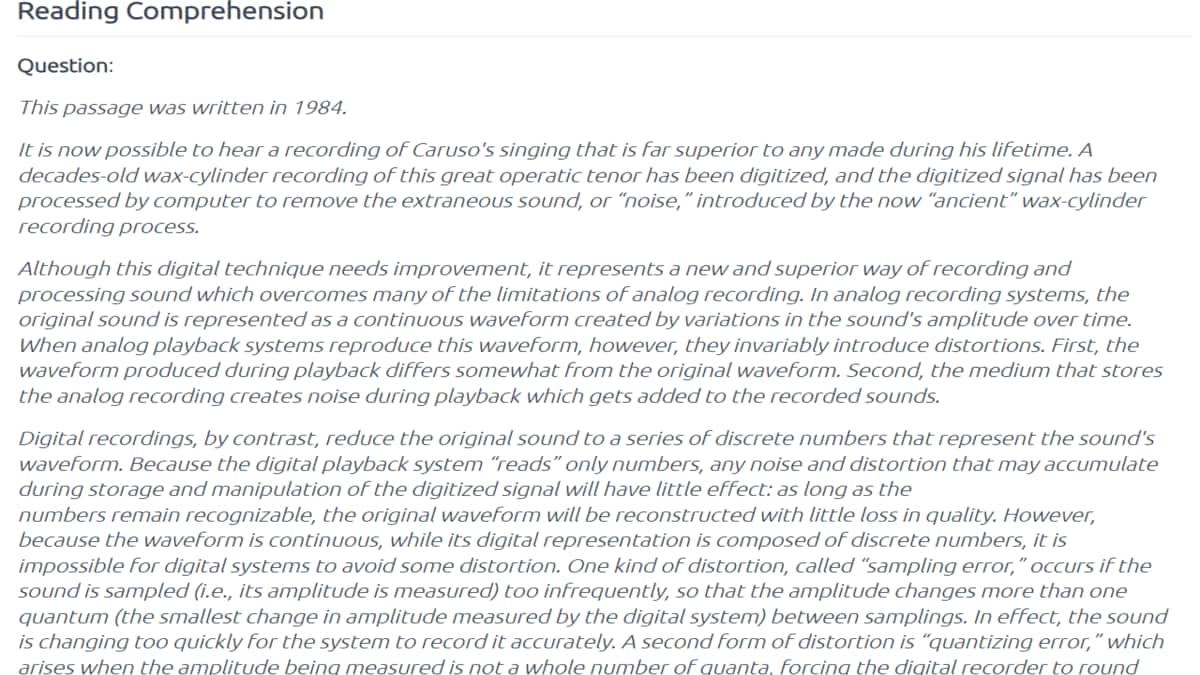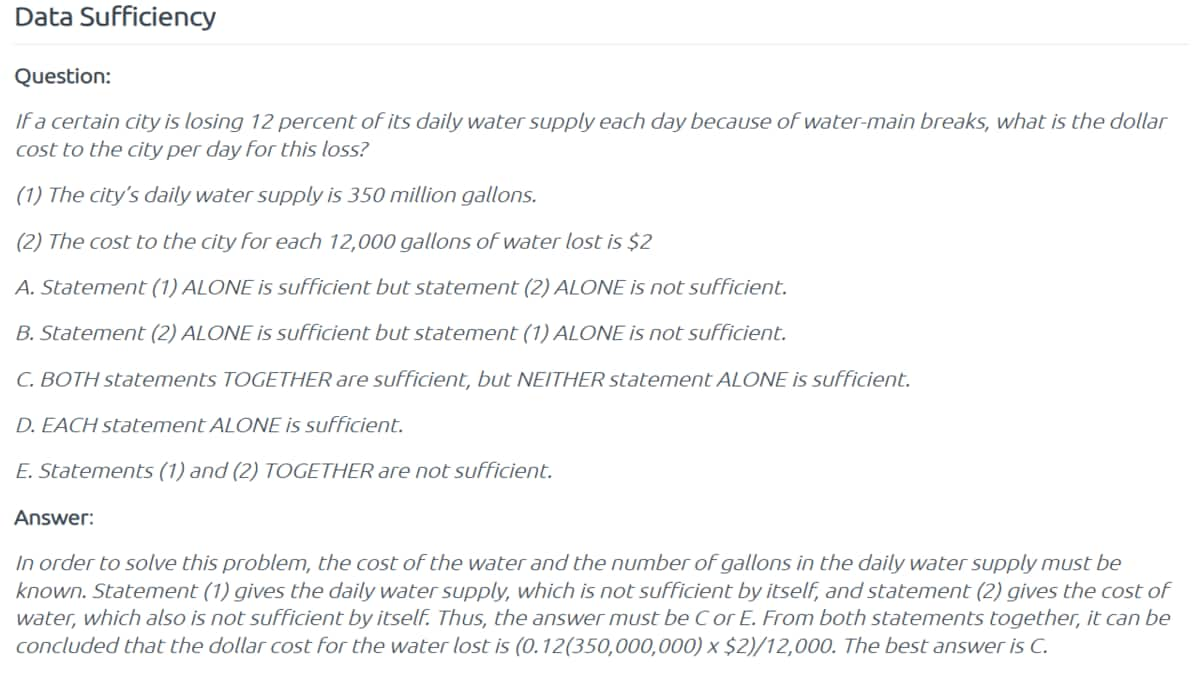GMAT Syllabus 2025: Section Wise QR, VR and DI Syllabus, Verbal, Quant, Data Insights
The GMAT syllabus is divided into three major sections, Quantitative Reasoning, Verbal Reasoning, and Data Insights. This 2-hours 15 minutes long examination includes a syllabus of a mix of topics such as Arithmetic algebra, data, analysis, verbal thinking, and others. The GMAT exam syllabus consists of 64 questions to be completed in 135 minutes (2 hours and 15 minutes), excluding an optional 10-min break. As per the GMAT format 2025, the Quantitative Reasoning section has 21 questions, the Verbal Reasoning has 23 questions and the Data Insights section has 20 questions, all of which need to be attempted in 45 minutes each. The quantitative reasoning section focuses on algebra and arithmetic while the verbal reasoning section focuses on critical reasoning and reading comprehension. The data insights is a newly introduced section that evaluates a candidate's ability to analyse and interpret data from various sources, such as tables, text passages, graphics, and multi-source reasoning. The latest GMAT syllabus includes no writing assessment. Candidates across the world take the GMAT for admission to top B-Schools of the world. Read the complete article to know the GMAT syllabus 2025 and all the other details.
This Story also Contains
- GMAT Exam Pattern 2025
- Latest GMAT Syllabus vs Previous GMAT Syllabus
- GMAT Syllabus 2025
- Key Sections of the GMAT Syllabus 2025
- Section wise GMAT Syllabus
- Quantitative Reasoning Syllabus
- GMAT Exam Tips for Quantitative Reasoning Section
- Verbal Reasoning Syllabus
- Tips for GMAT Verbal Reasoning Section
- Data Insights Syllabus
- Tips for GMAT Data Insights Section
- GMAT syllabus PDF 2025
- Preparation Tips
- GMAT Preparation Plan
- GMAT Preparation Books 2025
- GMAT Sample Questions and Answers
- What is Computer Adaptive in GMAT?

Read More: GMAT mock test
GMAT Exam Pattern 2025
Based on the latest changes in the GMAT pattern 2025, the table below shows all the sections, number of questions, question types, and timings for each section in the GMAT exam:
GMAT test section | Number of questions | GMAT question types | GMAT exam timings |
Quantitative Reasoning | 21 questions | Problem-solving skills | 45 minutes |
Verbal Reasoning | 23 questions | Critical reasoning and reading comprehension skills | 45 minutes |
Data Insights | 20 questions | Data literacy skills | 45 minutes |
| Total | 64 questions | - | 2 Hours 15 Minutes (along with an optional 10-minute break) |
Latest GMAT Syllabus vs Previous GMAT Syllabus
The latest GMAT syllabus is lesser when compared to the previous version. This is because two topics, the Analytical Writing Assessment and the Integrated Reasoning sections, are removed. However, a new topic, Data Insights has been introduced. The newly introduced Data Insights section includes data sufficiency, table analysis, multi-source reasoning, graphics interpretation, and two-part analyses. Each section of the GMAT subjects has a score range of 60-90. The GMAT total score range is 205-805.
GMAT Syllabus 2025
AWA (Analytical Writing Assessment) and SC (Sentence Correction) are removed, while a new section- Data Insights (DI) has been introduced in the GMAT latest exam syllabus.
| Sections | Syllabus |
|---|---|
| Quantitative Reasoning |
|
| Verbal Reasoning |
|
| Data Insights |
|
Related Articles:
Key Sections of the GMAT Syllabus 2025
- Quantitative Reasoning: This section includes 21 questions focused on arithmetic and algebra, with a time limit of 45 minutes. Notably, geometry questions have been removed from GMAT syllabus, and data sufficiency questions are now part of the Data Insights section.
- Verbal Reasoning: There are a total of 23 questions in this section of GMAT syllabus pdf download, and this section tests critical reasoning and reading comprehension skills, also within a 45-minute exam duration.
- Data Insights: A new addition to the GMAT syllabus 2025 pdf free download, this section consists of 20 questions that assess data literacy skills, including multi-source reasoning and graphics interpretation, and also has a duration of 45 minutes.
The total exam duration is 2 hours and 15 minutes, with an optional 10-minute break between sections.
Section wise GMAT Syllabus
While understanding the GMAT 2025 syllabus in detail, candidates must also understand the GMAT exam pattern 2025 and the type of questions asked in the exam.
- Quantitative Reasoning Section
- Verbal Reasoning Section
- Data Insights Section
Quantitative Reasoning Syllabus
The Quantitative Reasoning section in the GMAT syllabus 2025 comprises 21 questions in an MCQ format. This section evaluates the candidate's understanding of algebra and arithmetic fundamentals and their application in problem-solving scenarios. The students must complete all 21 questions within 45 minutes.
Questions for Geometry and Data Sufficiency have been removed from the latest exam pattern and now will be asked in the Data Insights section.
GMAT Quant Section Topics
- Multiples and Factors
- Fractions
- Number properties
- Decimals
- Percentage
- Power and Roots
- Average
- Set Theory
- Speed, time, distance
- Descriptive Statistics
- Ratio and proportion
GMAT Quant syllabus for Algebra:
- Monomials, polynomials
- Functions
- Exponents
- Progressions
- Permutation and combination
- Algebraic expressions and equations
- Inequalities and basic statistics
- Quadratic equations
Also Read:
GMAT Exam Tips for Quantitative Reasoning Section
These tips will help you perform better in the GMAT 2025 exam quant section:
- Begin from the scratch. Go through the Manhattan guides if you are not confident about your math.
- Write all the math formulae, and diffcult concepts somewhere and keep on revising them again and again.
- Create mnemonics and learn the difficult formulae
Verbal Reasoning Syllabus
The verbal reasoning section of the GMAT exam syllabus will have 23 questions to be completed in 45 minutes. The questions will be based on two types; reading comprehension and critical reasoning.
- Reading Comprehension- This section will test the candidate’s ability to comprehend the written material, draw inferences, and, understand the concept or relationship between the points involved in the passage. The passages can come from subjects like social sciences, humanities, physical and biological sciences, and business-related fields. The questions will be based on the main idea, supporting idea, inference, application, and logical structure.
- Critical Reasoning- The GMAT verbal syllabus will have MCQs based on short reading passages of less than 100 words. The questions measure the candidate’s ability to make arguments, analyse arguments, frame a plan of action, or draw a conclusion.
Tips for GMAT Verbal Reasoning Section
The following tips will make the GMAT 2025 verbal section much easier for you:
- Read the comprehension thoroughly, and make it a habit to write the main points of each paragraph.
- Learn to identify the gaps, assumptions, strengths, weaknesses, etc. in a given argument.
Data Insights Syllabus
This section has been incorporated to evaluate the ability of candidates to analyse and interpret data and apply it to real-world business scenarios. It is composed of 20 questions that have to be completed within 45 minutes.
GMAT Data Insights syllabus encompasses five types of questions:
- Data Sufficiency: Students' abilities to analyse a quantitative problem, identify pertinent data, and decide when there is sufficient data to solve the problem are evaluated in this section.
- Multi-Source Reasoning: This portion emphasizes examining data from multiple sources including text passages, tables, graphics, or some combination of the three.
- Table Analysis: This portion assesses the students' ability to categorise and evaluate a data table, akin to a spreadsheet, to identify pertinent information or data that satisfies predetermined criteria.
- Graphics Interpretation: This section includes questions about the ability to interpret the information presented in a graph or other graphical image to discern relationships, and make inferences.
- Two-Part Analysis: This section evaluates students' ability to solve complex problems in quantitative, verbal, or some combination of both.
Tips for GMAT Data Insights Section
The following tips for GMAT data insights section will make it much easier for you:
- Know and understand the different question types
- The DI section in the GMAT exam allows a basic calculator so master it
- Practice trends, comparisons, ratios, percentages and interpreting data from tables
- Use Estimation Techniques
- Approach Multi-Source Reasoning Smartly
- Practice Time Management
- Use Official Practice Tools
- Focus on Business Logic
- Review Mistakes by Question Type
GMAT syllabus PDF 2025
Candidates can find the GMAT syllabus PDF for free download, which includes detailed information about the GMAT exam pattern 2025 and the types of questions to expect.
Preparation Tips
It's not difficult to finish the GMAT Syllabus 2025 in three to six months. The following advice can assist candidates in organising their GMAT course preparation:
- Know the syllabus for GMAT and format inside and out.
- Students must begin preparation with the official GMAT study materials.
- Students can use Manhattan Prep's GMAT study guides after they have finished the approved study material. They are a reliable resource for the latest GMAT preparation. They can also refer to further resources like Veritas, Magoosh, etc.
- They must prepare by solving as many mock tests as possible.
Read more: GMAT preparation tips
GMAT Preparation Plan
A comprehensive GMAT prep plan includes going through the GMAT exam structure, setting achievable goals, dedicating sufficient time, and preparing from authentic and credible study resources. A typical plan includes foundational knowledge, practice with various question types, and practicing under timed conditions. It is important to do regular practice tests and analyse the weaknesses and strengths to improve the performance.
GMAT Preparation Books 2025
To achieve a high score in the GMAT 2025 exam, candidates must check the GMAT preparation tips. Candidates should refer to GMAT prep books that cover the entire GMAT 2025 syllabus and devote sufficient hours to practising different GMAT subjects. Below are some of the prep books for the test that will be useful in the preparation. They are easily available on Amazon and Flipkart.
- GMAT Official Guide Bundle
- Manhattan Prep’s “All the GMAT Bundle, 7th Edition”
- Kaplan’s “GMAT prep Plus”
- Mometrix “GMAT Prep Book”
- GMAT official Advanced Questions
- Power Score’s “GMAT Critical Reasoning Bible, 2021 Edition”
GMAT Sample Questions and Answers
Here are some GMAT sample questions to give a better understanding of the type of questions in the GMAT exam 2025. Practicing GMAT mock tests regularly before taking the test is a great way to work on your weaknesses and improve your performance.




Source: www.businessbecause.com
What is Computer Adaptive in GMAT?
Unlike other conventional exams, GMAT does not reward scores based on the number of correct answers. In this, when a candidate attempts a question correctly, he/she gets a bit difficult question and increases the scoring for the next question. On the other hand, if you attempt a question incorrectly, then the algorithm will put the next question at the same difficult level or lower, thereby reducing your chances to rapid-fire scoring chances.
Also Read:
Frequently Asked Questions (FAQs)
The GMAT exam covers chapters on topics such as Algebra, quantitative thinking, reading comprehension, and critical reasoning. Students must prepare thoroughly on the GMST syllabus to ace the exam.
The new GMAT exam has only three sections, namely quantitative, verbal, and data insights. The exam duration is reduced by 1 hour and the test takers are provided an optional 10-minute break in between the exam.
The current GMAT syllabus and CAT syllabus are almost the same. However, the difficulty level of some sections may vary. Hence, it cannot be stated that it GMAT is easier than CAT or not, as it also depends on an individual's exam preparation as well.
The current edition of GMAT exam consists of 3 sections, Quantitative Reasoning, Verbal Reasoning, and Data Insights. The exam duration is approximately 2 hours and 25 minutes which is reduced from the previous version of the exam.
Yes, it is enough for students to prepare for GMAT in 3 months. If the candidate prepares effectively by making a rigorous study plan and solves questions for each section on a daily basis, he/she will have higher chances of getting a higher score than other candidates. Also, practice is the key to success, and if the test takers will prepare by solving sample papers and practice question papers, they can achieve a score of over 700 marks by preparing effectively in 3 months.
To prepare for the GMAT 2025 exam, students must be well-versed with the test syllabus and pattern. They must practice regularly through official and updated best study materials. It is advisable to draft a study plan and stick to that.
Yes, you can apply for an MBA in Canada without a GMAT score, as some universities offer waivers or have alternative admission criteria based on work experience, academic achievements, or other factors. Institutions like the Schulich School of Business and the DeGroote School of Business offer such options. However, having a GMAT score can strengthen your application, especially for top-tier programs. For personalized guidance and to explore the best options tailored to your profile, consider consulting Invicta Career Consultancy, which specializes in helping students like you navigate the complexities of studying abroad.
Popular Courses and Specializations
Popular Degrees
Applications for Admissions are open.
Want to study in Ireland? Explore Universities & Courses
Study in Canada
ApplyExplore Universities, Courses & Subjects | Work while study
Study in UK
ApplyApply for upcoming intake & plan your journey
Study in USA
ApplyUniversities inviting applications | Get expert guidance
Study in Australia
ApplyShortlist best ranked universities & get expert guidance